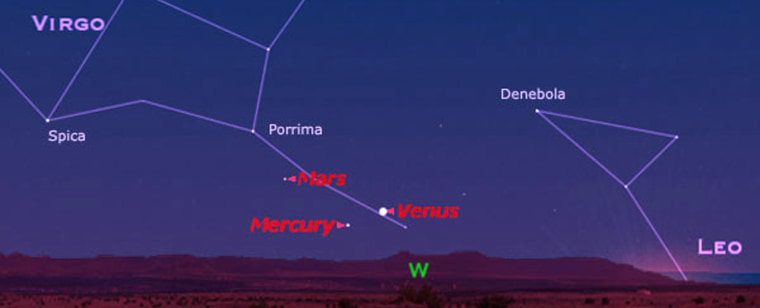Currently, the planet Venus is visible, albeit very low in the western evening sky right after sundown. Those with obstructions such as trees or buildings toward the west may not be able to see Venus yet, thanks to its low altitude. But this current evening apparition of Venus is going to evolve into a very good one in the coming days and weeks, so let's get into a fuller explanation of what is to come.
Venus passed superior conjunction (appearing to go behind the sun as seen from Earth) back on June 9. Initially, it was mired deep in the brilliant glare of the sun. Nonetheless, in the days that followed it moved on a steady course toward the east and pulled ever-so-slowly away from the sun's vicinity.
And now, during the last days of August and into early September, Venus has finally begun climbing up out of the sunset glow in earnest and is now about to reclaim its role as the brilliant "evening star," a title it has not held since the end of July 2007. Look for it now with binoculars shortly after sundown very low in the southwest.
Venus will stand about 10 degrees high in the western sky at sundown (your clinched fist held at arm's length is roughly 10 degrees wide) and will touch the horizon just a few minutes shy of a full hour after sunset, giving less experienced sky watchers a chance to get a good glimpse.
Fall and winter spectacle
In the following weeks, it should gradually become easier to see. By October 1, it will set about 30 degrees south of due west nearly 75 minutes after sunset. Continuing to swing east of the sun as the fall season progresses, Venus will become plainly visible in the southwestern evening sky even to the most casual of observers.
Slideshow 12 photos
Month in Space: January 2014
On the evening of December 1, Venus will team up with the planet Jupiter and a lovely crescent moon in the southwest sky right after sundown: the three brightest objects in the night sky gathering in a dramatic celestial tableau that will turn heads even of those who normally do not look up at the sky at night.
Appearing as a brilliant silvery-white starlike object of magnitude –4.3, our sister planet will set almost four hours after the sun by Christmas Day. In fact, if the air is very clear and the sky a good, deep blue, you might try looking for Venus shortly before sunset. As the sky darkens, it will seem to swell from a tiny white spark to a big, almost dazzling Christmas-season star.
Indeed, it will be during the winter of 2009 that Venus will perform like a sequined showgirl, calling attention to herself each evening.
An evening and morning star
Viewed in the western twilight, this planet always appears dazzlingly bright to the unaided eye, and more so in binoculars. Venus reaches its greatest elongation — its greatest angular distance — 47 degrees to the east of the sun on January 14. It will appear at its brightest in midwinter as it heads back down toward the sun, reaching its greatest brilliancy for this apparition on February 19 at magnitude –4.6. The planet will be most striking then, shining nearly twice as bright as it does now.
Venus will then slide back toward the glare of the sun, but because it will appear to pass more than eight degrees north of it when it passes inferior conjunction on March 27, a most unusual circumstance will take place for a few days around that time: Venus will be visible as both an evening and morning object, glowing low in the west right after sunset and also low in the east just before sunrise. It finally (almost reluctantly) will vanish for evening viewers view by the end of March.
Getting thinner ... and bigger
Between now and the end of March, repeated observation of Venus with a small telescope will show nearly a complete range of its phases and disk sizes. Currently, the planet appears almost full (92 percent sunlit on August 29), and through the first half of the upcoming fall season will display nothing more than a tiny, dazzling gibbous disk. It will start becoming noticeably less gibbous by early December.
In mid January 2009, Venus reaches dichotomy (displaying a "half moon" shape). Then, during February, it shows us an increasingly large crescent phase as it swings toward Earth. Indeed, those using telescopes will note that while the Earth-Venus distance is lessening, the apparent size of Venus' disk will grow, doubling from its present size by January 3. When it has doubled again in size on February 26, its large crescent shape should be easily discernable even in steadily held 7-power binoculars.
But even after it passes inferior conjunction on March 27, our Venus show will not be over, for it dramatically reemerges as a dazzling "morning star" low in the eastern sky by the beginning of April. Then, a repeat performance will begin, with the above sequence of events reversed. And that will continue right through to the end of 2009.

